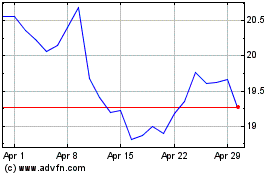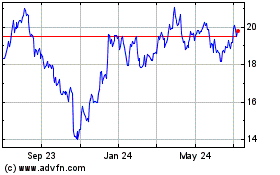U.S. Industrial Production Surged in April -- 2nd Update
May 16 2017 - 3:40PM
Dow Jones News
By Jeffrey Sparshott
WASHINGTON -- U.S. industrial output rose sharply in April, the
latest evidence that economic growth is picking up following a
lackluster start to the year.
Industrial production -- a measure of output at factories, mines
and utilities -- jumped 1.0% from a month earlier, the Federal
Reserve said Tuesday. That was the largest gain in more than three
years.
The strong showing follows a string of upbeat April indicators,
including the unemployment rate falling to its lowest level since
2007, solid consumer spending gains at online sellers, restaurants
and other retailers, and existing-home sales climbing at their
fastest pace in a decade. The broad-based growth across key sectors
of the economy suggests healthy demand from consumers and
businesses, reversing some gloomier readings from earlier in the
year.
"If you filter through the noise and look at the broader trend,
things are starting to get a little better," said Richard Moody,
chief economist at Regions Financial Corp.
Tuesday's report from the Federal Reserve showed manufacturing
output, the biggest component of industrial production, posted its
strongest gain since early in 2014, pushing the Fed's manufacturing
index to a new postrecession high.
U.S. factory activity was stagnant through much of 2015 and 2016
as the dollar strengthened, making U.S. goods more expensive to
sell overseas, and global economic growth remained tepid. Now, the
dollar has stabilized and overseas demand has picked up, helping
American factories.
It is less clear if April's strong performance will repeat. The
auto industry, which helped drive manufacturing output in April,
now faces plateauing sales. Auto makers sold 1.43 million vehicles
in the U.S. in April, down 4.7% from a year earlier, according to
Autodata Corp. The slump follows a record year for sales in 2016
and is leaving a glut of unsold vehicles piling up on dealer
lots.
Other sectors, such as electronics and food manufacturers,
posted smaller but perhaps more enduring gains.
"This will be remembered as the year when almost everything in
manufacturing got healthy except for motor vehicles," Michael
Montgomery, U.S. economist at IHS Markit, said in a research
note.
The Institute for Supply Management earlier this month said its
closely watched index of U.S. manufacturing activity fell in April
but still indicated the sector was expanding. ISM manufacturing
readings for each month this year have been higher than any month
in 2015 or 2016.
With the latest readings on the economy, forecasters expect a
pickup in gross domestic product from the paltry 0.7% annual rate
in the opening three months of the year. Macroeconomic Advisers, a
research firm, estimates second-quarter growth is tracking at a
3.9% pace.
Tuesday's Fed report showed output in the volatile mining sector
advanced 1.2% in April. The mining index, which includes oil and
natural gas extraction, was up 7.3% from a year earlier but remains
well below its peak. The sector had been weighed down by weak
commodity prices but appears to be rebounding.
Utility output rose 0.7% from the prior month but was down 0.5%
from a year earlier. Utility use is typically more a reflection of
the weather than economic vigor.
Write to Jeffrey Sparshott at jeffrey.sparshott@wsj.com
(END) Dow Jones Newswires
May 16, 2017 15:25 ET (19:25 GMT)
Copyright (c) 2017 Dow Jones & Company, Inc.
Regions Financial (NYSE:RF)
Historical Stock Chart
From Mar 2024 to Apr 2024

Regions Financial (NYSE:RF)
Historical Stock Chart
From Apr 2023 to Apr 2024
